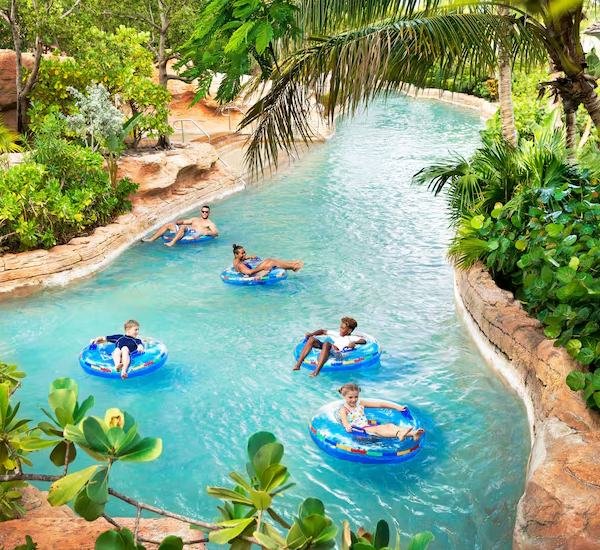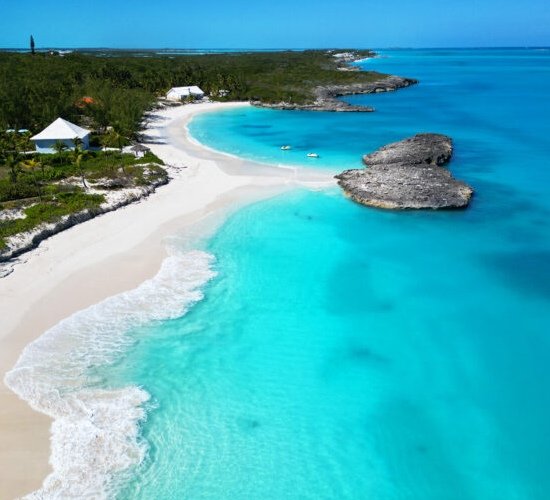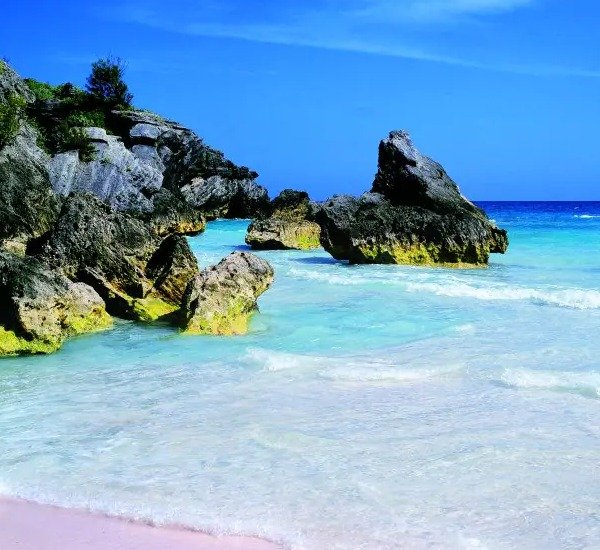The Bahamas
Eastern Standard Time (EST), UTC-5
Observes Daylight Saving Time (DST), shifting to UTC-4 from March to November
Consistent time zone across all islands
Bahamian Dollar (BSD), pegged 1:1 with the US Dollar
US Dollar (USD) widely accepted, especially in tourist areas
Credit cards (Visa, MasterCard) common; ATMs available in major hubs
July 10 - Independence Day
Marks independence from the UK in 1973 with parades, fireworks, and cultural events
Festivities centered in Nassau and Freeport
Visa-Free Countries
Visa on Arrival Countries
E-Visa Countries
Visa Required Countries
Culture
The Bahamas is a cultural mosaic, blending African, British, and American influences into a vibrant tapestry. This island nation, comprising over 700 islands and cays, is renowned for its infectious music, colorful festivals, and welcoming spirit, offering travelers an immersive experience in its rich heritage.
- Musical Traditions: At the heart of Bahamian culture is Junkanoo, a dynamic street festival held on Boxing Day (December 26) and New Year’s Day (January 1). Participants don elaborate, handcrafted costumes adorned with feathers, beads, and sequins, parading through the streets to the beat of goatskin drums, cowbells, and brass horns. Rake-and-scrape, a traditional music style, features the rhythmic scraping of a carpenter’s saw alongside accordion and drum beats, often heard at local gatherings. Calypso and reggae influences from the broader Caribbean also thrive, with artists like Ronnie Butler blending these genres into Bahamian hits. Music is a living tradition here, with impromptu performances common in markets and on beaches.
- Festivals: Beyond Junkanoo, the Bahamas hosts a range of celebrations that reflect its diversity. The Bahamas International Film Festival, held annually in Nassau, draws filmmakers and cinephiles with screenings of local and global works, often at historic venues like the Pompey Museum. The Pineapple Festival on Eleuthera celebrates the island’s sweet, juicy pineapples with food stalls, music, and pineapple-eating contests every June. Smaller events, like the Crab Fest on Andros, highlight regional traditions and seafood, offering visitors a taste of authentic island life. These festivals often feature traditional dances like the “heel and toe” polka, rooted in colonial times.
- Visual Arts & Architecture: Nassau’s colonial architecture is a visual testament to its history, with landmarks like the pink-hued Government House and the 18th-century Fort Charlotte showcasing British influence. The pastel-colored homes of Dunmore Town on Harbour Island evoke a quaint charm. The National Art Gallery of The Bahamas in Nassau, housed in a restored 1860s mansion, displays works by artists like Antonius Roberts, whose sculptures often incorporate native wood and explore post-colonial themes. Straw weaving, a craft inherited from African ancestors, produces intricate baskets and hats sold at markets like Nassau’s Straw Market.
- Literary Traditions: Bahamian literature reflects the nation’s complex identity, shaped by its history of slavery, colonialism, and natural beauty. Robert Antoni’s “As Flies to Whatless Boys” weaves historical fiction with the Bahamas’ pirate past, while poets like Marion Bethel address gender and heritage in works like “Guanahani, My Love.” Oral storytelling remains vital, with tales of “Rolling Calf” spirits and “Chickcharnie” creatures—mythical owl-like beings said to inhabit Andros—passed down through generations. These stories are often shared at community events or by guides during eco-tours.
- Cuisine: Bahamian food is a celebration of the sea, with conch as its star—served raw in tangy conch salad with lime and peppers, fried as crispy fritters, or stewed with tomatoes and spices. Other seafood delights include spiny rock lobster, often grilled with butter, and grouper fingers, a popular beachside snack. Staples like peas and rice (made with pigeon peas) and johnnycakes (dense cornbread) accompany most meals. Tropical fruits—guava, mango, and soursop—feature in desserts like guava duff, a steamed pudding with rum sauce. Drinks range from the refreshing “switcha” (limeade) to potent rum cocktails like the Bahama Mama, blending coconut rum, pineapple juice, and grenadine.
Tourism & Best Sites to Visit
The Bahamas is a premier Caribbean destination, famed for its turquoise waters, powdery beaches, and a mix of luxury and natural wonders. With over 700 islands, it offers something for everyone—whether you seek adventure, relaxation, or cultural immersion.



Atlantis Paradise Island: Located on Paradise Island, just off Nassau, this sprawling resort is a world unto itself. Its Aquaventure water park spans 141 acres, featuring thrilling slides like the Leap of Faith, a near-vertical drop through a shark-filled lagoon, alongside lazy rivers and 11 pools. The marine habitat, one of the largest open-air aquariums globally, houses over 50,000 sea creatures, including manta rays and sea turtles, with options for snorkeling or “Snuba” (a snorkel-scuba hybrid). Dining ranges from casual spots like the Village Burger Shack to Michelin-starred chef experiences at Fish by José Andrés. The Cove, an adults-only luxury section, offers private cabanas and a quieter vibe, while the casino and nightlife at Aura keep evenings lively. Accessibility is easy via a short bridge or water taxi from Nassau.
Exuma Cays: This archipelago of 365 islands in the central Bahamas is a paradise for explorers. The Exuma Cays Land and Sea Park, established in 1958, spans 176 square miles and protects vibrant coral reefs, making it a snorkeler’s and diver’s dream—expect to see parrotfish, lobsters, and pristine underwater caves. Big Major Cay’s swimming pigs, a quirky attraction, delight visitors who can feed them from boats (guided tours from George Town recommended). Compass Cay offers safe swimming with nurse sharks, while Thunderball Grotto—a cave with natural skylights—dazzles with its fish-filled waters, famously featured in “Thunderball” and “Never Say Never Again.” Staniel Cay’s boutique resorts and yacht club provide a base, with day trips available from Nassau or Great Exuma.
Pink Sands Beach: Stretching three miles along Harbour Island’s eastern shore, this beach’s rose-tinted sand—colored by microscopic foraminifera shells—creates a surreal landscape. The calm, shallow waters are ideal for swimming, kayaking, or paddleboarding, with coral reefs just offshore for snorkeling (gear rentable from nearby vendors). Luxe resorts like Coral Sands and Pink Sands Resort offer beachfront dining—think fresh lobster rolls—and spa treatments with ocean views. The island’s laid-back vibe shines in Dunmore Town, where golf carts are the main transport, and pastel cottages house cafes like Sip Sip, known for conch chili. Accessible by ferry from North Eleuthera (a 10-minute ride), it’s perfect for a day trip or a romantic getaway.
Transportation
Navigating the Bahamas’ 700+ islands requires a mix of air, sea, and land options, each offering unique advantages depending on your itinerary and budget.
- Inter-island Travel: Ferries and flights link the archipelago’s major hubs. Bahamas Ferries runs high-speed catamarans from Nassau to Eleuthera (2.5 hours), Exuma (4 hours), and Andros (2 hours), with air-conditioned cabins and onboard refreshments—book ahead for peak seasons (fares ~$60-$100 one-way). Domestic airlines like Bahamasair, Western Air, and Pineapple Air offer frequent flights; a Nassau-Exuma round trip might cost $150-$200, with 30-minute flights beating the ferry’s pace. Smaller charter planes serve remote cays, ideal for private groups or luxury travelers.
- Air Travel: Lynden Pindling International Airport (NAS) in Nassau is the primary entry point, handling flights from US cities like Miami (1 hour), New York (3 hours), and Atlanta (2 hours) via carriers like American Airlines and JetBlue. Grand Bahama International Airport (FPO) in Freeport serves as a secondary hub with US and Canadian connections. Both airports offer customs and immigration on-site, with NAS being the busier gateway for international arrivals—expect shorter queues at FPO.
- Water Transport: Boating is a Bahamian hallmark, with rentals ranging from small motorboats ($100/day) to luxury yachts ($1,000+/day) available in Nassau, Freeport, and George Town. Marinas like Albany in Nassau provide docking and fuel. Water taxis zip between Nassau and Paradise Island (5 minutes, ~$4) or connect smaller cays like Harbour Island to Eleuthera. For adventurers, guided boat tours explore hidden beaches and cays, often including fishing or snorkeling gear—check operators like Exuma Water Sports.
- Public Transport: Nassau’s jitneys—shared minibuses—run fixed routes (e.g., downtown to Cable Beach) for $1.25-$2, operating from early morning to around 7 PM; they’re affordable but crowded and less reliable after dark. Grand Bahama has similar services in Freeport. Out Islands lack formal public transport, relying instead on hitching or walking—locals are generally friendly to visitors needing a lift.
- Taxis: Licensed taxis, identifiable by their “Taxi” plates, are plentiful in tourist zones like Nassau, Freeport, and resort areas. Rates are regulated—Nassau airport to downtown is ~$32, to Cable Beach ~$20—but confirm fares beforehand as meters are rare. Hotels can arrange private transfers, and drivers often double as informal guides, sharing local tips. Tipping (10-15%) is appreciated for good service.
- Car Rental: Renting a car suits exploration on larger islands like New Providence, Grand Bahama, or Eleuthera. Agencies like Avis, Hertz, and local outfits (e.g., Kelly’s Car Rental) offer vehicles from $50-$80/day; book in advance for automatic transmissions, as manuals are common. Driving is on the left (UK-style), roads are narrow but paved in tourist areas, and gas stations are sparse on Out Islands—fill up in towns like George Town or Governor’s Harbour.
Airports
The Bahamas’ airports connect its islands to the world and each other, with two major international hubs and numerous smaller airstrips serving the Out Islands.
- Lynden Pindling International Airport (NAS): Named after the nation’s first prime minister, NAS is 10 miles west of Nassau and handles over 3 million passengers yearly. Its two terminals (US/Canada and International/Domestic) feature duty-free shops with Bahamian rum and cigars, eateries like Dunkin’ Donuts and Quiznos, and a first-class lounge with Wi-Fi and showers. US preclearance speeds departures to the States. Domestic flights to 20+ Out Islands depart hourly via Bahamasair and smaller carriers. Taxis and hotel shuttles are the main ground options—public buses stop a short walk outside. Expansion in 2013 modernized facilities, though peak times (December-April) can mean long lines.
- Grand Bahama International Airport (FPO): Located 3 miles north of Freeport, FPO serves Grand Bahama with flights from Miami, Fort Lauderdale, and Toronto via American Eagle, Sunwing, and Bahamasair. The single terminal offers basic amenities—gift shops, a café (try the conch fritters), and car rental desks (Avis, Budget). Domestic connections link to Nassau and Abaco. It’s quieter than NAS, ideal for travelers avoiding crowds, though hurricane damage in 2019 (Dorian) has slowed full recovery—check flight schedules. Taxis to downtown Freeport (~$15) or Lucaya (~$20) are readily available.
Visa & Travel Information
The Bahamas welcomes tourists with straightforward entry policies and practical travel considerations, ensuring a smooth visit to its tropical shores.
| Nationality | Entry Option | Maximum Stay | Notes |
|---|---|---|---|
| USA, Canada, UK | Visa-Free | Up to 8 months | Passport valid for 6 months required |
| EU Countries | Visa-Free | Up to 3 months | Schengen rules may apply for extensions |
| Other Countries | Visa Required | Varies (30-90 days typical) | Apply via Bahamian embassies; check online |
Visa Requirements: US, Canadian, and UK citizens need only a passport valid for six months beyond their stay, with a return ticket and proof of funds (e.g., bank statement) sometimes requested by immigration. EU visitors get 90 days visa-free, extendable with approval from the Department of Immigration in Nassau. Visa-required nationals (e.g., India, China) must apply in advance, providing travel itineraries and accommodation details—processing takes 2-4 weeks (~$100 fee). Cruise passengers staying less than 72 hours often bypass visa rules if docking at Nassau or Freeport.
Health Considerations: No mandatory vaccines, but the CDC recommends hepatitis A, typhoid, and routine shots (MMR, Tdap). Mosquito-borne diseases like Zika and dengue are risks—use DEET repellent (30%+ strength) and wear long sleeves at dusk, especially in rainy months (June-November). Tap water is potable in Nassau and Freeport, but bottled water is advised on Out Islands. Private clinics (e.g., Doctors Hospital in Nassau) offer quality care; travel insurance covering medical evacuation (to Florida, if needed) is wise, as public hospitals can be under-resourced.
Safety Tips: Crime is low in tourist zones, but petty theft occurs—keep wallets in front pockets and avoid flashy jewelry. Nassau’s Over-the-Hill area and Freeport’s backstreets are riskier after dark; stick to well-lit areas or taxis. Swimming is safe at patrolled beaches (e.g., Cable Beach), but riptides occur—heed red flags. Hurricane season (June-November) brings risks; monitor NOAA updates and have a flexible itinerary. Emergency numbers: 911 (general), 919 (police).
Currency: The Bahamian Dollar (BSD) equals the USD, with coins in 5¢, 10¢, and 25¢ denominations featuring pineapples and fish. US cash dominates—vendors give BSD change, so clarify if needed. ATMs dispense both currencies (Scotiabank, RBC common); exchange booths at airports charge fees (~2%). Tipping mirrors the US: 15% at restaurants (check for auto-gratuity), $1-$2 for bellhops, $5-$10 for guides.
Practical Tips: EST (UTC-5) aligns with the US East Coast, with DST from March to November. Power is 120V/60Hz, using US-style Type A/B plugs—adapters unnecessary for North Americans. Dress is casual (shorts, flip-flops), but cover-ups are expected in towns; smart casual suits upscale dining. Internet is reliable in cities (BTC, Aliv providers), with Wi-Fi at hotels and cafes, though spotty on remote cays—buy a local SIM (~$15) for data. Respect local customs: greet with “Good morning” and avoid photographing people without permission.
- Asia
- Singapore
- Japan
- South Korea
- Africa
- Seychelles
- Mauritius
- South Africa
- Contact:
- Address: Eighth Avenue Place, East Tower, 525 8 Avenue SW Suite 3200 Calgary, Alberta T2P 1G.
- Email: Info@theazmip.com
- Number: +12812363495
Travel the World Without the Burden of Visa Applications, as TheAzmip.com Connects You to the Best Visa-Free Destinations.
- North America
- United States
- Canada
- Mexico
- Oceania
- Australia
- New Zealand
- Samoa

